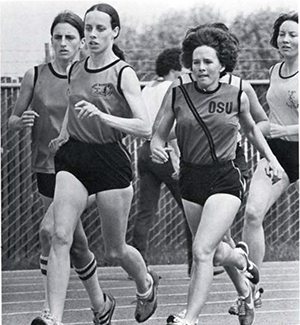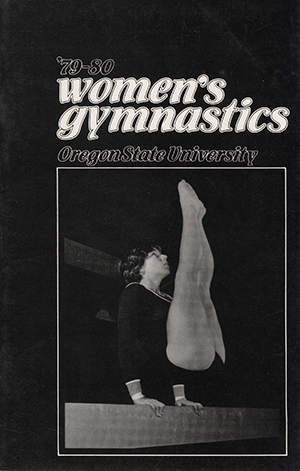From the Winter 2023 issue of the Oregon Stater magazine
As a teen, Rebecca “Becky” Niemi longed to compete, but her 1960s Tigard High School didn’t offer team sports for girls. Then, at 30, a mother of two, Niemi enrolled at Oregon State University and suddenly participating became a possibility.
But was it too late? She approached the track coach. “I asked, ‘Does age count? Can I still get in at age 30?’ She said, ‘I don’t know why not.’”
A year later in 1976, Niemi earned a spot on the first cross country team to represent Oregon State at the Association for Intercollegiate Athletics for Women nationals.
 “My four years of running meant a lot to me,” Niemi, ’79, said. “Just having been able to be on a team. I never thought that would ever happen.”
“My four years of running meant a lot to me,” Niemi, ’79, said. “Just having been able to be on a team. I never thought that would ever happen.”
It was all thanks to Title IX, legislation enacted by Congress in June 1972 that prohibits sexual discrimination in any educational program or activity receiving federal financial aid.
Prior to Title IX, women athletes made the best of what they had and did what they could without the rest.
While men were provided uniforms, equipment, airfare and prime practice times, women generally took care of themselves. If they needed safety gear, they provided it. Transportation to an event? They drove. Gender-specific equipment? Not likely. And practice? Set the alarm for dawn.
While the act made no mention of athletics, in few fields has the impact been greater.
The landmark legislation, an amendment to the Civil Rights Act of 1964, opened up new opportunities for scholarships and increased participation, as well as access to better equipment, premium venues and countless other resources men’s teams took for granted.
Last month, Oregon State celebrated the 50th anniversary of Title IX with the induction of the all-women 2022 Hall of Fame class. The Nov. 5 ceremony at Reser Stadium also honored a group of “Title IX Trailblazers” for their role in paving the way for current and future generations of Oregon State athletes. (See all the Hall of Fame honorees at bit.ly/TitleIX2022 and the list of Trailblazers at bit.ly/OSUtrailblazers.)
“Title IX changed my life,” said Niemi, inducted as an individual and as part of the 1977 cross country team. In the early 1960s, she didn’t question why the only sports available to high school girls were cheerleading, pep squad and the annual powder puff derby (when they were given the chance to suit up in football gear for fun). “It was never something that was put out there. It was kind of like, ‘No, girls don’t do that kind of stuff.’ This was my chance to be able to do something I always wanted to do.”
Yet, when Niemi qualified for the nationals in Madison, Wisconsin, her coach didn’t think the department had the money to send her. Niemi’s husband, Larry, a high school teacher and coach, thought otherwise.
“He was very vocal about it,” Niemi said. “He wanted to be sure she knew they would not be in compliance with Title IX.” In the end, Niemi, another runner and the coach were able to go.
“As a result of that, I was able to do something I really enjoyed,” she said. “It got me out, got me focused on doing something I always wanted to do. It gave me the opportunity to meet new people, see how hard I could push myself, learn to make decisions, deal with failure, accept criticism, and there’s the work ethic that comes out of that. The girls up and coming saw me and said ‘If she can do it, I can too.’”
 Title IX also changed Donna (Southwick) Alarcon Elizondo’s life, though in the mid-1970s, she knew nothing about the new legislation. In 1976, she led the Linn-Benton Community College gymnastics team to the National Junior College Athletic Association championship and was named all-around individual champ. But that was to be the end of her college career. There was no money to go further. While her husband would continue his education on the GI Bill, Alarcon Elizondo resigned herself to a future in a low-paying job.
Title IX also changed Donna (Southwick) Alarcon Elizondo’s life, though in the mid-1970s, she knew nothing about the new legislation. In 1976, she led the Linn-Benton Community College gymnastics team to the National Junior College Athletic Association championship and was named all-around individual champ. But that was to be the end of her college career. There was no money to go further. While her husband would continue his education on the GI Bill, Alarcon Elizondo resigned herself to a future in a low-paying job.
“Next thing you know I’m getting a call from Ron Ludwig, the coach, saying OSU is offering me an athletic scholarship based on Title IX,” Alarcon Elizondo recalled. She was the first woman to receive an athletic scholarship from Oregon State.
“There were more opportunities. There was more recruiting. They were now able to give opportunities to women that were before just for men,” said Alarcon Elizondo, who was recognized at the November celebration. “It made it so girls felt like now they had a chance for an athletic scholarship and would be able to continue their sport of choice. That was very big.”
Alarcon Elizondo went on to become the first Oregon State All-American in women’s athletics. Instead of toiling away in a minimum wage job as she’d feared, she opened her own gymnastics school. One of the main disparities that stands out for many women student-athletes from the years before Title IX was in equipment. Mary Newman, ’81, recognized at the Hall of Fame ceremony as a Title IX trailblazer and inducted as part of the 1980 and 1981 softball teams, remembers women buying their own safety equipment, practicing in the Women’s Building gym and having to take their uniforms home to be laundered.
“It was so goofy,” Newman said. “Men had the best of everything. We were just the siblings that were little and disadvantaged. We did not have safety equipment. So, if you were a catcher, your catcher’s gear was either self-supplied or inherited, passed down from generation to generation. We knew the men’s baseball team was not like that. They had all kinds of practice gear and safety gear provided. They had the big face mask, the chest protector, shin guards and whatnot. I don’t think there even was a training program for the women.”
Swimming and rowing coach Astrid Hancock — the only coach inducted this year into the Hall of Fame — also remembers the lack of appropriate equipment. While she coached at OSU from 1964-1973, women rowers used the men’s boats, which were designed to the scale of a man’s body. They showered and changed in an old house while the men had a new locker room, and the women rowers trained with a male coxswain.
When they traveled to meets, they used the equipment available at the meet, equipment that wasn’t adjusted to them, equipment they didn’t know. The odds were against them before the starting gun went off. Team members began raising money to buy their own equipment by taking on odd jobs on campus and around town. They cleaned up the stadium and painted address numbers on the front of people’s houses.
Despite the inequities, the men and women got along well, even competing together in mixed events.
“Since we didn’t own any of our equipment, we used the men’s boats,” Hancock said. “They weren’t always too happy about that. One time they got a new racing shell, and we finally convinced them we could use that. The women ended up landing up on the docks and got a crack in it. That wasn’t so good.”
Like the equipment, travel was also different for women. Most of the men’s teams flew to games out of state. Save for the occasional national event, the women drove. Sharing the long miles in the vans made for some memories, but also some difficult times. Women’s basketball coach Aki Hill remembered her assistant coach sleeping in the car on recruiting trips, and Hill’s husband picking up the dinner tab for the team on the road. “We had a great time anyway,” said Hill. “We didn’t want to complain.”
Complaining would have meant using energy and time that could have been better spent playing ball and producing a good team, she said. “It was my privilege to go step by step. Luckily, in 1995, finally we packed the gym. I think we sometimes outdrew the men’s game. It took a long time. But we did it.”
Hill, who coached OSU Women’s Basketball from 1978-1995, is the winningest coach in Oregon State Women’s Basketball history. Her 1979 National Women’s Invitational Tournament finalist and 1980 NWIT champion teams were recognized in this year’s Hall of Fame ceremony as trailblazers.
 Carol Menken-Schaudt, ’81, was a member of both the 1979 and 1980 teams, but had it not been for Title IX, a four-year college would not have been an option. She was a student at Linn-Benton Community College when she was recruited to play for Oregon State’s newly formed women’s basketball team. That led to a partial scholarship and then two full-year scholarships.
Carol Menken-Schaudt, ’81, was a member of both the 1979 and 1980 teams, but had it not been for Title IX, a four-year college would not have been an option. She was a student at Linn-Benton Community College when she was recruited to play for Oregon State’s newly formed women’s basketball team. That led to a partial scholarship and then two full-year scholarships.
It was her time playing under Hill that led to her place on the U.S. women’s 1984 gold-medal Olympic basketball team. She ended up playing professionally for eight seasons, including six years in Italy and two in Japan. She still holds Oregon State’s career records for points (2,243), rebounds (901) and field goal percentage (.692).
“I really grew under her leadership,” Menken said of Hill. “I really became a national player through those three years.”
Change in women’s sports did come, though it didn’t happen overnight, said Sylvia Moore, who served as director of Women’s Athletics, after Pat Ingram, during implementation of Title IX.
Prior to the legislation, women’s sports had to borrow equipment from the physical education department. “It was probably the late ’70s before we began getting equipment that was just used by the athletic program,” she said. “We worked with [OSU presidents] Dr. MacVicar and then Dr. Byrne after that. It just gradually grew over time. That was due to the support of the university presidents because they recognized they couldn’t treat women students differently than male. It wasn’t a rapid progress; it was an evolution.”
The evolution led to safety equipment and gear designed specifically for a woman’s body. Players no longer had to practice at dawn and had access to the weight rooms and better gym times. There was also more money for recruitment and outreach.
“Once Title IX came in, there was lots of interest in women’s athletics,” Hancock said. “By 1974, there were so many people coming out for rowing, they had to cut people. In 1970 and ’71, we had only eight people on the team. That doubled in ’72 and ’73 to 14 or 15 and then by ’74, I can’t even count how many people were going out for the team.”
There’s no doubt Title IX changed the world of sports and continues to do so. The Women’s Sports Foundation reports that girls’ participation in high school sports is 12 times higher than it was in 1972 with 3 million more sports activities available for high school girls. Likewise, in collegiate sports, women now make up 44% of all NCAA student-athletes, compared to 15% pre-Title IX.
“It essentially put women’s sports on the map and provided the framework for opportunities and resources to flow to young female athletes who wanted equal footing to compete and perform at the same high level as men,” Newman said.
“Looking back at the fact that there are now professional leagues for women’s basketball and soccer and intercollegiate competition in so many sports that attract multimillions in attendance and revenue dollars — that didn’t happen by accident. It was Title IX opening the doors to resources and recognition that was key to attracting athletes, sponsors and the public supporting that women are phenomenal athletes and worth watching. It has been wonderful to see.”
But, she said, “The work to bring equality to women’s sports is not done and still needs care and attention to ensure we do not go backwards and that the gains made over time do not reverse.”
So far, most agree the movement continues to move forward. Not only has the playing environment improved dramatically, but — not surprisingly — so too have the players.
“The product on the court is a much better product than the three years I was at Oregon State. There’s certainly a bigger fan base,” Menken said. “You learn so much through sports. You develop so many skills that just change the trajectory of your life. I’m encouraged by the opportunities the women have today.”
Learn more about today’s efforts to increase scholarships, improve facilities and more for Oregon State University women’s sports at bit.ly/osu-fearless.

